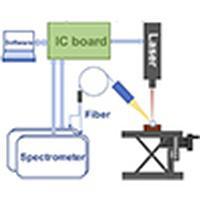当前位置:
X-MOL 学术
›
Opt. Express
›
论文详情
Our official English website, www.x-mol.net, welcomes your
feedback! (Note: you will need to create a separate account there.)
High accuracy determination of copper in copper concentrate with double genetic algorithm and partial least square in laser-induced breakdown spectroscopy.
Optics Express ( IF 3.2 ) Pub Date : 2020-01-20 , DOI: 10.1364/oe.381582 Haochen Li , Meizhen Huang , Huidi Xu
Optics Express ( IF 3.2 ) Pub Date : 2020-01-20 , DOI: 10.1364/oe.381582 Haochen Li , Meizhen Huang , Huidi Xu

|
There are many challenges in the determination of elements in complex matrix such as soil, coal and minerals by laser induced breakdown spectroscopy (LIBS) method. Due to the influence of matrix effect, instability of laser plasma and fluctuation of laser parameters, the repeatability and accuracy of quantitative results are always not satisfactory. In order to improve the accuracy, high-energy laser (30mJ-100mJ) with precise control was utilized in many laboratories. In this paper, quantitative analysis of copper in copper concentrate by low-energy (10µJ) LIBS is studied. In order to reduce the influence of matrix effect and other factors, a partial least square regression method based on double genetic algorithm (DGA-PLS) is proposed. The detail operations are as follow: the reference spectral lines are automatically selected by GA as the optimal internal standard for spectral normalization. Then the GA is used to select variables from the normalized spectra for PLS. The results showed that, for univariate model, the coefficient of determination (R2) was improved from 0.6 to 0.97 by the optimal internal standard normalization. Compared with tradition PLS, the root mean square error of cross validation (RMSECV) and root mean square error of prediction (RMSEP) of PLS trained by the normalized spectral data decreased from 1.4% and 0.42% to 0.9% and 0.29% respectively. Compared with the normalized PLS, the RMSECV and RMSEP of the DGA-PLS trained by the normalized and feature selected spectral data decreased from 0.9% and 0.29% to 0.26% and 0.21% respectively. The results show that DGA-PLS can significantly reduce matrix effect, improve prediction accuracy and reduce the risk of overfitting in determination of copper in copper concentrate.
中文翻译:

双重遗传算法和偏最小二乘在激光诱导击穿光谱中高精度测定铜精矿中的铜。
用激光诱导击穿光谱法(LIBS)测定复杂基质中的元素(例如土壤,煤炭和矿物质)时面临许多挑战。由于基质效应,激光等离子体的不稳定性和激光参数的波动的影响,定量结果的可重复性和准确性始终不能令人满意。为了提高精度,许多实验室采用了具有精确控制的高能量激光(30mJ-100mJ)。本文研究了通过低能(10µJ)LIBS定量分析铜精矿中铜的方法。为了减少矩阵效应等因素的影响,提出了一种基于双遗传算法的偏最小二乘回归方法。具体操作如下:GA会自动选择参考光谱线作为光谱归一化的最佳内标。然后将GA用于从PLS的归一化光谱中选择变量。结果表明,对于单变量模型,通过最佳内标归一化,确定系数(R2)从0.6提高到0.97。与传统的PLS相比,归一化光谱数据训练的PLS的交叉验证均方根误差(RMSECV)和预测均方根误差(RMSEP)分别从1.4%和0.42%降低到0.9%和0.29%。与归一化的PLS相比,归一化和特征选择光谱数据训练的DGA-PLS的RMSECV和RMSEP分别从0.9%和0.29%降低到0.26%和0.21%。
更新日期:2020-01-17
中文翻译:

双重遗传算法和偏最小二乘在激光诱导击穿光谱中高精度测定铜精矿中的铜。
用激光诱导击穿光谱法(LIBS)测定复杂基质中的元素(例如土壤,煤炭和矿物质)时面临许多挑战。由于基质效应,激光等离子体的不稳定性和激光参数的波动的影响,定量结果的可重复性和准确性始终不能令人满意。为了提高精度,许多实验室采用了具有精确控制的高能量激光(30mJ-100mJ)。本文研究了通过低能(10µJ)LIBS定量分析铜精矿中铜的方法。为了减少矩阵效应等因素的影响,提出了一种基于双遗传算法的偏最小二乘回归方法。具体操作如下:GA会自动选择参考光谱线作为光谱归一化的最佳内标。然后将GA用于从PLS的归一化光谱中选择变量。结果表明,对于单变量模型,通过最佳内标归一化,确定系数(R2)从0.6提高到0.97。与传统的PLS相比,归一化光谱数据训练的PLS的交叉验证均方根误差(RMSECV)和预测均方根误差(RMSEP)分别从1.4%和0.42%降低到0.9%和0.29%。与归一化的PLS相比,归一化和特征选择光谱数据训练的DGA-PLS的RMSECV和RMSEP分别从0.9%和0.29%降低到0.26%和0.21%。










































 京公网安备 11010802027423号
京公网安备 11010802027423号